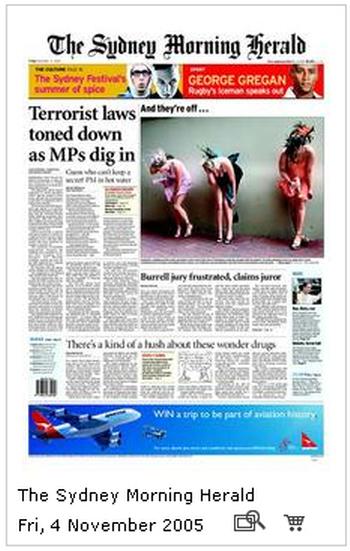Sydney Botanical Garden-Homeward Bound
The paper this morning has a great photo on the front page, taken from another race at Flemington Park in Melbourne. The costumes and the weather conditions seem to be very similar to those described for the Melbourne Cup, so I saved a copy as a souvenir of "our" race.
As usual for Sydney (in my vast experience) the day has dawned threatening rain. As usual we need to get an early start. Whatever we want to achieve today we want to get done before 11am. This gives us way too much time to get to the airport, but much more importantly allows us to enjoy whatever we are doing without being accompanied by rock and hard place, our front and back packs. Good friends though they've been, our morning stroll will be considerably more pleasant without their additional 70lbs or so.
The one place left on our checklist is the Botanical Garden. This is an excellent choice because it is on both our lists, it will provide exercise and fresh air, the more of which we can suck up before 20 hours of flying the better, it is cheap, and it opens early. 'Nuff said. |
|
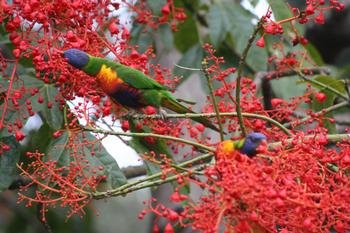 |
We select a route that runs through the more formal Hyde Park, where we stop for a long time to attempt to photograph a pair of unbelievably photogenic Rainbow Lorikeets, which turn out to be even more impossible to capture than yesterday's flock of Sulphur-Crested Cockatoos.
We pass two or three squads of about a dozen folks each doing what appears to be kick-boxing training exercises. It must be the in-thing, because they almost outnumber the runners who are the only other discipline out in any kind of numbers. |
|
 |
 |
|
The Royal Botanic Gardens occupy one
of Sydney's most spectacular
positions. Established in
1816, the Royal Botanic Gardens & Domain provide valuable green space in the
center of the city. Visitors enjoy observing our birds and many come just to see
our colony of flying foxes. You can also expect outdoor evening events to be
accompanied by the occasional sounds of possums jumping through the trees.
Mammals include Grey-headed Flying Foxes, possums (Ringtail and
Brush-tailed), rats and the occasional feral cat. You will encounter flying foxes
roosting during the day, but most other
mammals can only be seen at night. Flying
foxes are large bats, weighing up to 1 kg,
with a wing span which may exceed one
meter. Food sources include pollen, nectar
and fruit from a wide variety of trees. Only
the Grey-headed Flying Fox (Pteropus
poliocephalus) occurs within the Royal
Botanic Gardens. They damage roost trees
by stripping leaves and growth shots from
the canopy of the trees. This can have a
dramatic affect on roost trees and it can take
a very long time for the trees to recover.
Flying-foxes are important pollinators and
seed disperses of native trees and other
plants. Seeds are discarded in the feces or
fall where the fruit is being eaten. These
seeds germinate when conditions are
suitable and ensure that dispersal occurs over
a wide area.
|
|
 | |
 |
|
There is also a splendid piece of folk art/graffiti in the form of a shopping bag dangled over the arm of an otherwise pompous-looking statesman.
The scenery changes dramatically the second we pass through the ornamental gates proclaiming the entrance to the gardens. A serenity descends, passers-by are working at a much more leisurely pace. As you'd expect it's an appreciable amount of real estate, overrun with crisscrossing paths.
We're tempted to ask for directions towards our main point of interest, the fruit bats, but we're glad we don't expose ourselves to such ridicule. It is shortly clear that the correct response would be along the lines of "walk two more minutes at random, then shake your stick. If you don't hit one, turn yourself in as a hopeless cause."
Yikes! Tree after tree is absolutely laden with them. They should be called fruit bats because that's what they look like, not because of what they eat. Grapefruits hanging in individual sacks. Thousands of them. It's a perfect time to be there. Light enough to see, but there is plenty of activity as everyone jostles for a parking space. |
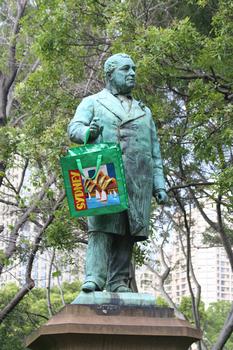 |
 |
I make myself motion sick trying to capture shots of them swooping overhead. Wayne says "is it raining?" It is, but not from the heavens. Considering how many bats are overhead, and how much guano there is on the ground, I guess we're lucky that this is the only direct hit. |
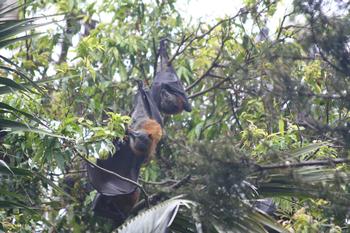 |
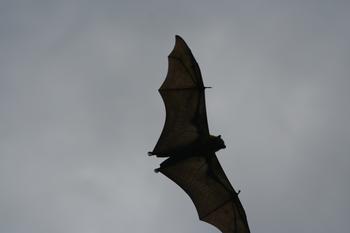 |
As an interesting piece of scatological trivia, unlike birds, bats don't evacuate while parked. Think about it, it makes sense. So you are only at any serious risk on take off and landings, but at this time of day they are doing a lot of those. While Wayne washes off in the bathroom, I get off my favorite shot of the Opera House |
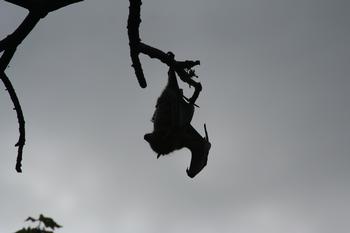 |
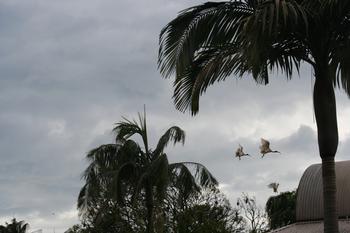 |
and bridge which from this distance emphasizes the beautifully contrasted pairing that I noticed on the first day, and it reminds me that the Opera House was designed to be exactly (within an inch) half the height of the bridge, confirming to me that the designer Jørn Utzon also clearly perceived the two constructions as a pair. |
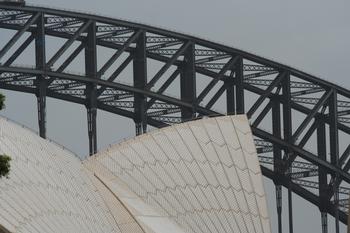 |
 |
As we meander towards the Opera House, there's a man sitting out on the lawn under one of the trees. A pair of birds, brazen as you like are perched in the low branches above his head. Wayne doesn't recognize the birds, and I'm surely no help, so he studies them through his bins. For several moments. "Socks!" We suppose the man must be homeless, and he was waiting for his washing to dry. My big lens also makes the socks pretty clear.
When we finally exit the garden, we're on the steps of the Opera House. This is as close as Wayne has been, or wants to be. But he ascends the steps and takes some snaps. I sit and ponder. This is the third time now that I ended up at the quay side, and I realize the we've seen almost nothing else of Sydney. But it doesn't seem to matter. |
Whenever the kids have brought friends with them on vacation, we've tried to take them to see things that they recognize —Niagara Falls, Statue of Liberty, Empire State—on the grounds that is seems to me to help ground yourself, to convince you that you really are where the pilot says he brought you. Otherwise you could have just circled for a couple of hours. Provided you landed somewhere unfamiliar, how are you really supposed to tell if this is the real deal or not?
So the Sydney Harbor Bridge and the Opera House were the two man-made objects that were on the top of my list to see.
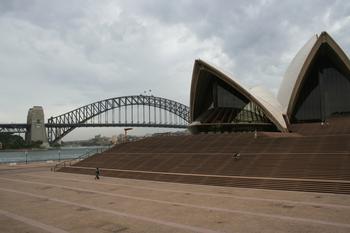 |
And here they are, facing each other across the quay. Why look any further? If you throw in the adjoining Botanical Garden and the Rocks, it is certainly as compact, varied, and picturesque a set of tourist destinations as one could hope to find on the planet. |
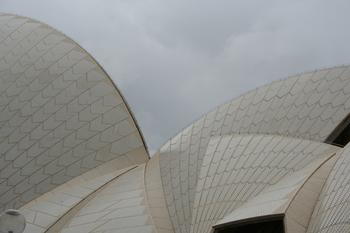 |
 |
I'm therefore content to sit and stare at one or other of them as many times as you like, trying to burn the image and the moment into long-term memory. I'm reluctant to leave, so we stop at one of the quay side cafes and order a couple of coffees. Now we are under the cover at least of an umbrella it finally starts to rain (from the heavens). |
 |
 |
So we leave in pretty much exactly the same time and conditions as I found the place two weeks and a life time ago. Despite the weather, we decide to walk back to the hotel, which by chance takes us passed a final surprise. There is an anchor from one of the ships in the second fleet, which sank off Norfolk Island? in? It looks remarkably primitive, and is a stark reminder of how far we've come in so just two hundred years.
|
 |
 |
I have three bags: my check-in backpack, my cabin backpack, and my emu-egg bag. The emu egg I bought all the way back on KAngaroo Island is in the protective care of a stuffed kangaroo but I'm still petrified of it being knocked, kicked, dropped or crushed. It spends most of the trip between my legs, whether I'm standing in yet-another line, or sitting on an airplane for 12 hours. I feel like a penguin protecting its egg against the Antarctic winter. |
|





